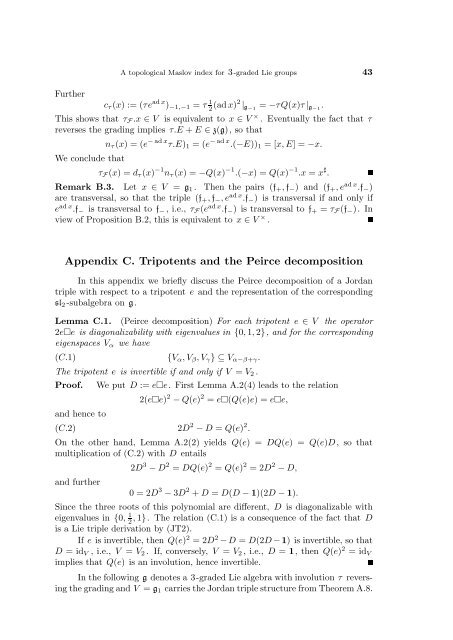A topological Maslov index for 3-graded Lie groups - ResearchGate
A topological Maslov index for 3-graded Lie groups - ResearchGate
A topological Maslov index for 3-graded Lie groups - ResearchGate
Create successful ePaper yourself
Turn your PDF publications into a flip-book with our unique Google optimized e-Paper software.
Further<br />
A <strong>topological</strong> <strong>Maslov</strong> <strong>index</strong> <strong>for</strong> 3-<strong>graded</strong> <strong>Lie</strong> <strong>groups</strong> 43<br />
cτ(x) := (τe ad x )−1,−1 = τ 1<br />
2 (adx)2 |g−1<br />
= −τQ(x)τ |g−1 .<br />
This shows that τF.x ∈ V is equivalent to x ∈ V × . Eventually the fact that τ<br />
reverses the grading implies τ.E + E ∈ z(g), so that<br />
We conclude that<br />
nτ(x) = (e − ad x τ.E)1 = (e − ad x .(−E))1 = [x, E] = −x.<br />
τF(x) = dτ(x) −1 nτ(x) = −Q(x) −1 .(−x) = Q(x) −1 .x = x ♯ .<br />
Remark B.3. Let x ∈ V = g1. Then the pairs (f+, f−) and (f+, e ad x .f−)<br />
are transversal, so that the triple (f+, f−, e ad x .f−) is transversal if and only if<br />
e ad x .f− is transversal to f−, i.e., τF(e ad x .f−) is transversal to f+ = τF(f−). In<br />
view of Proposition B.2, this is equivalent to x ∈ V × .<br />
Appendix C. Tripotents and the Peirce decomposition<br />
In this appendix we briefly discuss the Peirce decomposition of a Jordan<br />
triple with respect to a tripotent e and the representation of the corresponding<br />
sl2-subalgebra on g.<br />
Lemma C.1. (Peirce decomposition) For each tripotent e ∈ V the operator<br />
2ee is diagonalizability with eigenvalues in {0, 1, 2}, and <strong>for</strong> the corresponding<br />
eigenspaces Vα we have<br />
(C.1) {Vα, Vβ, Vγ} ⊆ Vα−β+γ.<br />
The tripotent e is invertible if and only if V = V2.<br />
Proof. We put D := ee. First Lemma A.2(4) leads to the relation<br />
and hence to<br />
2(ee) 2 − Q(e) 2 = e(Q(e)e) = ee,<br />
(C.2) 2D 2 − D = Q(e) 2 .<br />
On the other hand, Lemma A.2(2) yields Q(e) = DQ(e) = Q(e)D, so that<br />
multiplication of (C.2) with D entails<br />
and further<br />
2D 3 − D 2 = DQ(e) 2 = Q(e) 2 = 2D 2 − D,<br />
0 = 2D 3 − 3D 2 + D = D(D − 1)(2D − 1).<br />
Since the three roots of this polynomial are different, D is diagonalizable with<br />
eigenvalues in {0, 1,<br />
1}. The relation (C.1) is a consequence of the fact that D<br />
2<br />
is a <strong>Lie</strong> triple derivation by (JT2).<br />
If e is invertible, then Q(e) 2 = 2D2 −D = D(2D −1) is invertible, so that<br />
D = idV , i.e., V = V2. If, conversely, V = V2, i.e., D = 1, then Q(e) 2 = idV<br />
implies that Q(e) is an involution, hence invertible.<br />
In the following g denotes a 3-<strong>graded</strong> <strong>Lie</strong> algebra with involution τ reversing<br />
the grading and V = g1 carries the Jordan triple structure from Theorem A.8.

















